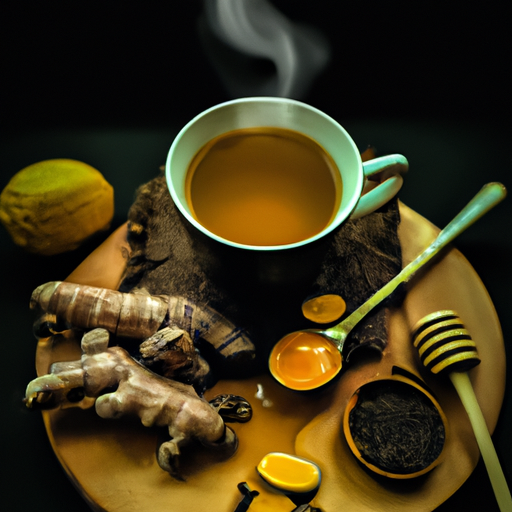I have been struggling with chronic pain and inflammation for some time now, and I understand firsthand how irritating it can be to seek relief. After experimenting with various medications and therapies with little success, I discovered turmeric tea as a natural remedy to alleviate my symptoms.
Turmeric, a spice commonly used in Indian cuisine, has anti-inflammatory properties that have been shown to help relieve pain and swelling in the body. In fact, studies have found that curcumin, the active ingredient in turmeric, may be just as effective as some anti-inflammatory drugs but without the harmful side effects.
If you’re looking for a natural way to manage your pain and inflammation, making turmeric tea at home is an easy and delicious option that you can incorporate into your daily routine.
Key Takeaways
- Choosing quality and organic ingredients is important for making turmeric tea.
- Adding black pepper and honey can enhance the health benefits and flavor of turmeric tea.
- Other herbs and spices such as ginger, lemon, cinnamon, nutmeg, or cardamom can be added to experiment with the flavor.
- Pregnant women should consume turmeric in moderation to avoid uterine contractions or bleeding, while breastfeeding women can benefit from its anti-inflammatory properties.
The Benefits of Turmeric
You’re going to love how turmeric can help reduce your pain and inflammation! Turmeric is a spice that has been used for centuries in traditional medicine. It contains an active ingredient called curcumin, which has anti-inflammatory properties. These properties make it effective in reducing pain and swelling.
Not only does turmeric help with pain and inflammation, but it also has benefits for skincare and digestive health. Curcumin has been shown to improve skin conditions such as acne, eczema, and psoriasis. Additionally, turmeric can aid in digestion by increasing the production of bile in the liver. This helps break down fats and improves overall gut health.
By incorporating turmeric into your diet, you’ll not only feel better physically but also see improvements in your skin’s appearance.
Now that you know about the benefits of turmeric, let’s move on to selecting the right ingredients for making turmeric tea.
Selecting the Right Ingredients
To properly prepare this healing beverage, it’s important to carefully choose the ingredients you’ll use. Choosing quality and sourcing ingredients are essential steps in making a delicious and effective turmeric tea. Here are some tips on selecting the right components for your brew:
-
Choose fresh turmeric root if possible, as it contains higher levels of curcumin, the compound responsible for many of turmeric’s health benefits.
-
Look for organic ginger root and black pepper to ensure that these spices are free from pesticides and other harmful chemicals.
-
Consider adding other herbs or spices such as cinnamon, cardamom, or cloves to experiment with blends and ratios that suit your taste preferences.
-
Use high-quality honey or maple syrup as a natural sweetener instead of refined sugar, which can counteract the anti-inflammatory effects of turmeric.
-
Opt for filtered water instead of tap water to avoid any impurities that may affect the taste and quality of your tea.
By choosing the right ingredients, you’ll be able to make a potent and tasty turmeric tea that can help reduce pain and inflammation.
Now that you have all the necessary components at hand, let’s move on to preparing your tea using simple but effective methods.
Preparing Your Tea
Ready to enjoy a warm and soothing beverage that can boost your immune system and provide various health benefits? Let’s dive into the simple yet effective process of preparing this healing tea.
The first step in making turmeric tea is selecting quality ingredients, but now it’s time to brew the tea. There are various tea brewing techniques, such as steeping or boiling, but I recommend simmering the turmeric root in water for 15-20 minutes. This method allows all the nutrients to be extracted from the root and infused into your drink.
Once you’ve simmered the turmeric, add black pepper and honey for added health benefits and flavor. Strain out any remaining pieces of turmeric before enjoying your cup of golden goodness.
Now that you have prepared your turmeric tea, it’s time to add some flavor! In the next section, we’ll discuss how to customize your tea by adding additional herbs or spices to suit your taste preferences.
Adding Flavor to Your Tea
Now that you’ve got your cup of turmeric tea, why not spice things up and add some extra flavor to suit your preferences? Here are a few creative infusion ideas and flavorful tea blends that can enhance the taste of your turmeric tea:
- Add a slice of fresh ginger or lemon for a refreshing twist.
- Mix in a teaspoon of honey or maple syrup to sweeten the taste.
- Sprinkle in some cinnamon, nutmeg, or cardamom for a warm and cozy flavor.
- Experiment with different types of milk such as coconut milk or almond milk to create a creamy texture.
By adding these simple ingredients, you can transform your basic turmeric tea into a delicious and unique beverage.
However, if you prefer alternative ways to enjoy turmeric, keep reading to discover more options beyond just drinking it as tea.
Alternative Ways to Enjoy Turmeric
I love incorporating turmeric into my diet in different ways, and there are many alternative options besides just making tea.
One great way to get your daily dose of turmeric is by adding it to smoothies. You can also take turmeric supplements if you don’t enjoy the taste or want a more concentrated form.
Lastly, cooking with turmeric can add a flavorful and healthy twist to any dish.
Adding Turmeric to Smoothies
Transform your bland smoothie into a healing elixir by adding a pinch of turmeric. This flavorful spice not only adds depth to your drink, but also has numerous health benefits.
Turmeric is known for its anti-inflammatory properties, which can help reduce pain and swelling in the body. It contains a potent antioxidant called curcumin that fights against free radicals and may even help prevent chronic diseases like cancer and Alzheimer’s.
If you’re looking to add turmeric to your smoothie recipes, start with just a pinch and gradually increase the amount as you get used to the taste. You can also pair it with other spices like ginger or cinnamon for added flavor and health benefits.
Some great smoothie ideas include turmeric mango, turmeric banana, or even a green smoothie with spinach and kale.
Adding turmeric to smoothies is just one way to reap its many benefits, but if you’re not a fan of drinking it, there are other options available such as turmeric supplements. These supplements come in various forms including capsules or powders and can be easily incorporated into your daily routine.
Turmeric Supplements
Sure, you could take turmeric supplements if you want to be like every other health enthusiast out there buying into the latest trend. But before you do, let me give you some pointers about how to choose the best brands and determine the right dosage for your needs.
- Look for a reputable brand that sources organic or non-GMO turmeric.
- Make sure the supplement contains black pepper extract (piperine) to enhance absorption.
- Follow recommended dosages and consult with a healthcare professional if you have any concerns or medical conditions.
Aside from reducing pain and inflammation, turmeric also offers benefits for skin health. Its anti-inflammatory properties can help reduce acne and eczema, while its antioxidant content can improve overall complexion and reduce signs of aging.
Now, let’s move on to incorporating turmeric in cooking.
Turmeric in Cooking
Incorporating turmeric in your cooking can add a flavorful and healthy twist to your meals. Turmeric has been used for thousands of years in Ayurvedic medicine for its healing properties. It contains curcumin, a natural anti-inflammatory compound that helps reduce pain and inflammation in the body.
Turmeric can be added to various dishes such as soups, stews, rice, vegetables, smoothies, and even desserts like cakes and ice cream. There are many creative ways to use turmeric in cooking that not only provide health benefits but also enhance the flavor of your food. Making turmeric tea is also an easy way to incorporate this spice into your diet. You can find many variations of turmeric tea recipes online that you can try out at home.
As with any supplement or spice, there are possible side effects to consider when consuming turmeric.
Possible Side Effects
Be aware that turmeric tea may have some possible side effects, such as an upset stomach or nausea. Interestingly, a study found that taking high doses of turmeric for long periods of time can lead to liver problems in rare cases. It’s important to note that these side effects are not common, and most people can consume turmeric in moderation without any issues.
However, if you do experience any discomfort after drinking turmeric tea, there are a few tips you can keep in mind. Firstly, make sure to drink plenty of water throughout the day to stay hydrated and flush out any toxins from your system. Additionally, it’s recommended to start with small doses of turmeric and gradually increase over time as your body becomes more accustomed to it. If you still experience side effects despite following these tips, it may be best to consult with a healthcare professional before continuing the use of turmeric.
Moving on to precautions for certain groups, it’s important to note that pregnant women should avoid consuming large amounts of turmeric as it may stimulate contractions or even cause miscarriage. Individuals who are scheduled for surgery should also discontinue using turmeric at least two weeks before their procedure since it may interfere with blood clotting and increase bleeding risk during surgery.
Precautions for Certain Groups
As someone who enjoys drinking turmeric tea, it’s important to note that certain groups should exercise caution when consuming this beverage.
Pregnant and breastfeeding women, as well as individuals with gallbladder issues, should be aware of potential risks and consult their healthcare provider before incorporating turmeric into their diet.
While turmeric has many health benefits, it’s always better to err on the side of caution and prioritize one’s overall health and well-being.
Pregnant Women
Pregnant mamas, you’ll be happy to know that turmeric tea can help alleviate your pain and inflammation safely. However, it’s important to consume it in moderation as excessive consumption may lead to uterine contractions or bleeding.
The recommended dosage for pregnant women is 1 teaspoon of turmeric per day. Turmeric contains curcumin which helps reduce inflammation and boost immunity. It can also aid digestion and provide relief from heartburn during pregnancy.
If you’re unsure about consuming turmeric, always consult with your doctor before adding it to your diet. Now let’s move on to the next subtopic about breastfeeding women.
Breastfeeding Women
As a pregnant woman, I was cautious about what I consumed to ensure the safety of my growing baby. Now that I’m breastfeeding, my concerns have shifted to how certain foods or drinks may affect my milk supply and baby’s health.
Fortunately, turmeric tea is one natural remedy that can benefit both me and my little one. Turmeric tea has anti-inflammatory properties that can help manage pain and inflammation while breastfeeding. The curcumin found in turmeric works as an anti-inflammatory agent that can reduce breast engorgement or mastitis, which can cause discomfort and swelling in the breasts.
Additionally, turmeric can boost the immune system, helping protect both mother and baby from illness during this vulnerable time. When consuming turmeric tea while lactating, it’s important to drink it in moderation as excessive amounts could cause gastrointestinal issues for some individuals.
It’s also recommended to consult with your healthcare provider before adding any new supplements or remedies into your diet while breastfeeding. With proper guidance and care, incorporating turmeric tea into your daily routine can be a natural way to manage pain and inflammation while ensuring the safety of your little one.
Transitioning into our next topic about people with gallbladder issues…
People with Gallbladder Issues
If you’re someone who struggles with gallbladder issues, incorporating certain foods into your diet can be a lifesaver. Following a gallbladder diet that’s low in fat and high in fiber can help reduce the risk of painful attacks. It’s important to avoid fried foods, dairy products, and fatty meats, as these can trigger discomfort.
Here are four items to consider when planning your gallbladder diet:
- Increase your intake of fruits and vegetables to get more antioxidants and fiber.
- Choose lean proteins like chicken or fish instead of red meat.
- Incorporate healthy fats like nuts, seeds, avocado, and olive oil.
- Add turmeric to your meals or make turmeric tea for its anti-inflammatory properties.
When it comes to using turmeric for pain relief, it’s important to note that the dosage may vary depending on the individual’s needs. However, studies have shown that consuming 400-600mg of curcumin (the active ingredient in turmeric) per day may help reduce inflammation and pain associated with various conditions including arthritis and irritable bowel syndrome.
Incorporating turmeric into your daily routine through cooking or drinking tea can be an easy way to reap its benefits.
Incorporating Turmeric into Your Daily Routine
To easily incorporate turmeric into your daily routine, try adding a teaspoon of it to your morning smoothie or sprinkling it on roasted vegetables for a flavorful boost. Another delicious and popular option is making a turmeric latte, which combines turmeric with warm milk and spices like cinnamon and ginger.
Additionally, you can use turmeric in DIY face masks for its anti-inflammatory properties. Turmeric has been used for centuries in traditional medicine to reduce pain and inflammation. Incorporating it into our diets or skincare routines can be an easy way to reap its benefits.
However, if you’re looking for other natural ways to reduce pain and inflammation, there are various options available that we’ll explore next.
Other Natural Ways to Reduce Pain and Inflammation
I want to share with you some other natural ways I’ve found helpful in reducing pain and inflammation.
Firstly, regular exercise has been shown to reduce joint pain and stiffness.
Secondly, making changes to your diet can also play a significant role in reducing inflammation – incorporating more anti-inflammatory foods such as leafy greens, fatty fish, and berries can make a big difference.
Lastly, stress reduction techniques like meditation or yoga can help alleviate both physical and emotional stressors that contribute to inflammation in the body.
Exercise
You can think of exercise as a powerful tool to fight pain and inflammation, like a sword that slashes through the discomfort. There are many ways to incorporate exercise into your daily routine, even if you’re dealing with chronic pain.
Finding motivation to exercise can be challenging, but it’s important to remember the benefits it provides. Exercise helps reduce inflammation by increasing blood flow and promoting the release of endorphins, which are natural painkillers.
When starting an exercise routine, it’s best to start small and gradually increase intensity over time. Low-impact exercises such as walking or swimming can be helpful for those with joint pain. Stretching is also important before and after exercising to prevent injury and improve flexibility. It’s important to listen to your body and not push yourself too hard, especially when experiencing pain.
Incorporating exercise into your daily routine is just one step towards reducing pain and inflammation. The next step involves making dietary changes that complement your newfound physical activity routine.
Diet Changes
Switching up your eating habits can have a profound impact on how you feel every day, giving you the power to take control of your health and wellbeing. One way to support pain and inflammation reduction is by incorporating turmeric tea into your diet.
Turmeric, a spice commonly used in Indian cuisine, has been shown to have anti-inflammatory properties due to its active ingredient curcumin. By drinking turmeric tea regularly, you can benefit from its nutritional benefits and potentially reduce pain and inflammation.
To start enjoying the benefits of turmeric tea, incorporate it into your meal planning. You can easily make it at home by boiling water with grated or powdered turmeric root for 10-15 minutes before straining it into a cup. For added flavor, you can add honey or lemon juice. Additionally, consider adding other anti-inflammatory foods such as ginger, garlic, leafy greens, and fatty fish into your meals for an overall healthier diet that contributes to reduced pain and inflammation levels.
By taking steps towards improving our diets through simple changes like drinking turmeric tea regularly or incorporating more anti-inflammatory foods into our meals, we’re also taking steps towards reducing chronic stress. This will be further discussed in the subsequent section about stress reduction strategies.
Stress Reduction
To take the edge off of stress, sometimes it’s helpful to take a step back and smell the roses. This can be achieved through techniques like meditation and yoga.
Meditation is a practice that helps train your mind to focus on the present moment, without judgment or distraction. It can help reduce stress by calming down your nervous system and reducing anxiety levels.
Yoga is another way to reduce stress and enhance relaxation. It combines physical postures with breathing exercises and meditation techniques to improve flexibility, strength, balance, and mental clarity. Yoga has been shown to lower cortisol levels (the stress hormone) in the body while improving mood and overall well-being.
Adding even just a few minutes of meditation or yoga into your daily routine can make a big difference in reducing stress levels and promoting overall health.
Frequently Asked Questions
What is the recommended dosage of turmeric tea for reducing pain and inflammation?
I recommend consuming 400-600mg of turmeric extract up to three times a day for pain and inflammation reduction. Consult with a healthcare professional before adding supplements to your routine. Different preparation methods may affect dosage recommendations.
Can turmeric tea interact with any medications?
Turmeric tea may interact with certain medications, such as blood thinners and diabetes drugs. It’s important to consult a healthcare provider before consuming turmeric tea if you are taking any prescription medications. Other natural remedies for pain and inflammation include ginger, omega-3 fatty acids, and boswellia.
How long should I steep the turmeric tea for maximum benefits?
I researched the optimal steeping time and turmeric quality for maximum benefits. Steeping for 10-15 minutes with high-quality turmeric can enhance curcumin absorption, which may reduce inflammation and pain. Consult a healthcare professional before using turmeric as a supplement.
Can I add honey or other sweeteners to my turmeric tea?
Yes, I can add honey or other sweeteners to my turmeric tea. Some popular options include coconut sugar, maple syrup, and stevia. Experiment with different Turmeric Tea Recipes and Variations to find your perfect blend of sweetness.
Are there any specific brands or types of turmeric that are more effective for pain relief?
I’ve found that turmeric brands with high curcumin content, like Gaia Herbs and Solgar, are effective for pain relief. Drinking turmeric tea regularly can also bring health benefits, so experiment with different recipes to find what works best for you.
Conclusion
I hope this article has been helpful in teaching you how to make turmeric tea to reduce pain and inflammation. Turmeric is a powerful spice that’s been used for centuries for its medicinal properties, and now we know why. It contains compounds called curcuminoids, which have anti-inflammatory and antioxidant effects.
One interesting statistic is that a study published in the Journal of Medicinal Food found that consuming 500-2,000 mg of turmeric per day can lead to significant reductions in joint pain and stiffness in people with osteoarthritis. This shows just how effective turmeric can be as a natural remedy for pain management.
Remember to always select high-quality ingredients when making your tea and follow the proper preparation methods to ensure maximum benefits. But also keep in mind possible side effects and precautions for certain groups before incorporating turmeric into your daily routine.
There are also other natural ways to reduce pain and inflammation, so do your research and find what works best for you!










